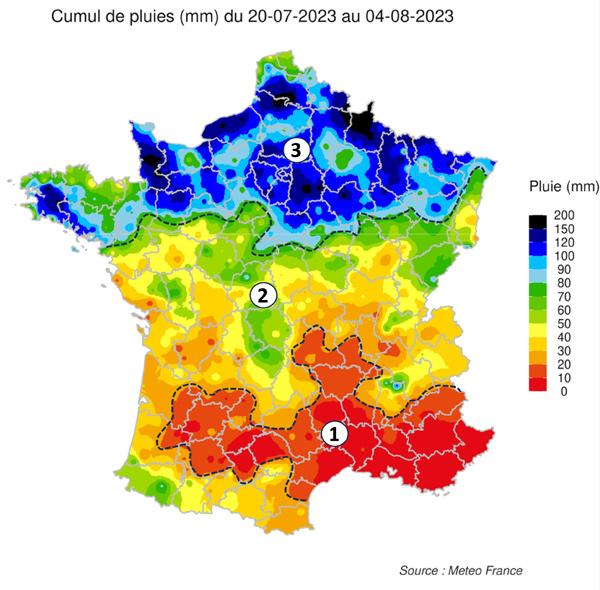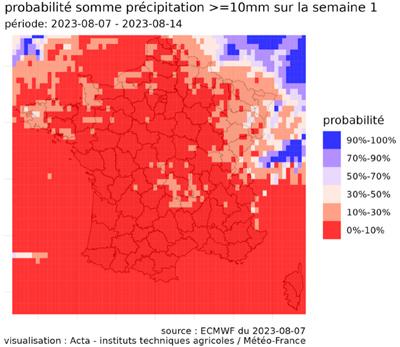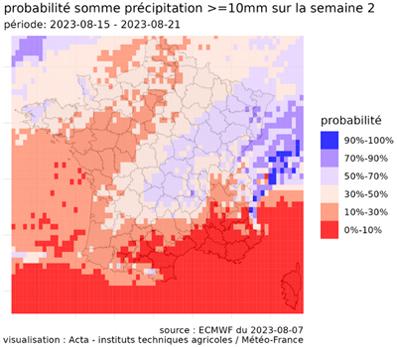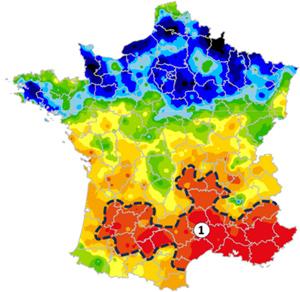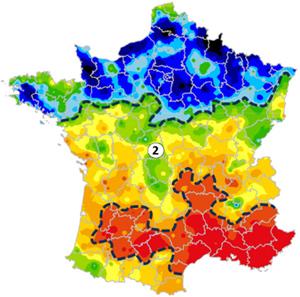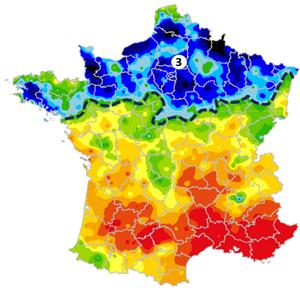Should I start sowing rapeseed?
Should I start sowing rapeseed?
Take decisions based on past and forecast meteorological conditions
Sectors affected by the problems of autumn insects, requiring early emergence (before September 1, particularly on shallow soils) fall within the recommended sowing ranges, so the question of when to start sowing arises. Dry weather is forecast for the next 10 days, but the moisture accumulated since 20 July in a large northern half of the country offers a window of opportunity for good emergence conditions. Terres Inovia provides an update on the situation and the factors to be taken into account to help you make the decision to sow oilseed rape in the next few days.
What situations are covered for sowing between 10 and 15 August?
As a reminder, the decision to sow is taken in two stages:
- First, set the optimum sowing range according to the soil and climate (see map below).
- Then, once you have entered the optimum range, start sowing according to the state of the soil and the weather forecast.
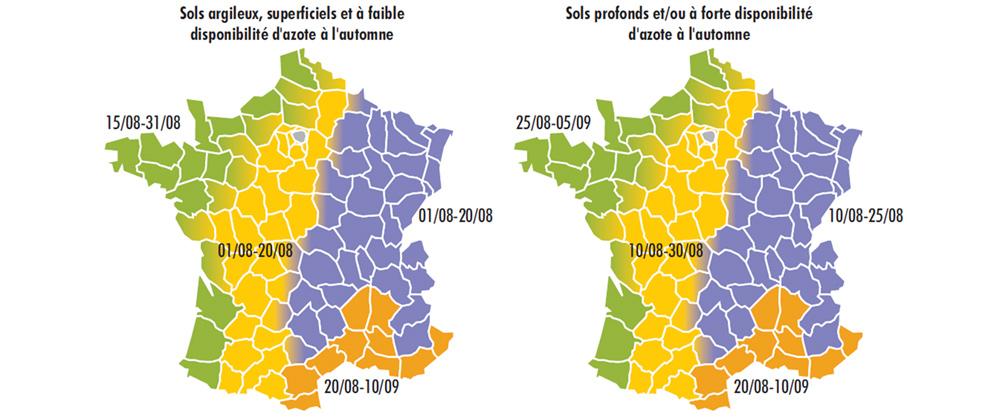
Although early sowing is less justified in deep soils with high nitrogen availability and in the west of France than in shallow soils, the favourable conditions for emergence coupled with dry weather forecast for at least 15 days may encourage this year's early sowing window to be seized.
There is also the climatic situation in July, with heavy rainfall in areas where the harvest may not yet be complete (mainly on the coast), and which will therefore not be affected by this question of sowing oilseed rape before 15 August..
Reminder of the benefits and risks of early sowing around 15 August ?
An analysis of the benefit/risk balance suggests that early sowing is the best option. Reminder of the parameters to be taken into account:
Advantages of early drilling :
- Avoid the risk of adult flea beetles by emergence before 1 September and reaching the 4-leaf stage before 20 September.
→ Enable rapid emergence and dynamic growth of the rapeseed by taking advantage of the favourable temperatures at the end of August and September. - Benefit from more frequent rainfall in August, and particularly in the first 15 days, than at the beginning of September, which is favourable to emergence and the effectiveness of root herbicides.
Risks of early sowing :
- Early nitrogen starvation (October) in soils with low nitrogen availability:
→ Can make rape crops vulnerable to damage from flea beetle larvae and terminal bud weevil.
→ Can be compensated for by applying nitrogen fertiliser locally (maximum 10U) or in the field (maximum 30U before 1st September in accordance with current regulations) and combining gelatinous legumes with oilseed rape. It should be noted that low bioavailability of phosphorus in plots can also penalise rapeseed growth in the autumn. In these situations, it is particularly advisable to apply phosphorus in late summer before the crop is planted.
- The risk of rapeseed elongation:
→ Can lead in particular to increased sensitivity to frost
→ Is linked to sowing density, varietal susceptibility and emergence date - a combination of factors. An elongated oilseed rape is better than one that never emerges. In deep soils with high nitrogen availability, early sowing is possible but it is advisable to avoid over-densities (no more than 30-35 emerged plants per m² in conventional sowing and no more than 20-25 in precision sowing) and to avoid varieties with a high susceptibility to autumn elongation.
Key to the decision: weather conditions in previous and forthcoming weeks
Cumulative rainfall to 4 August 2023
| | As the period from 1st to 20th July was generally dry throughout the country, it is the cumulative rainfall since 20th July that should be taken into account to explain the current meteorological and soil moisture conditions in the various sectors.At present, 3 zones can be distinguished according to rainfall totals over the last 2 weeks:
|
Rainfall forecasts to 8 August
|
|
|
ACTA has produced maps showing the probability of cumulative rainfall over the next two weeks (August 7 to 14 and August 14 to 21). These maps provide additional information to the weather forecasts to help decision-makers. These maps are updated every day at 10.30 am on the ALEAPLUIE website. As the maps above show, the weather forecasts predict a very low probability of receiving at least 10mm over most regions over the next two weeks, except for the southern third of France. Conditions are therefore rather unprecedented, with cool to wet soils, and for once, it is past rainfall totals that will influence the decision to sow, rather than future rainfall.
Thinking about when to start sowing
Many farmers are wondering whether they should start sowing oilseed rape. The conditions for successful oilseed rape emergence are met in many situations: detailed explanations below to help you make the right decision.
There are several criteria to take into account when deciding whether to start sowing:
- The presence of freshness in the profile,
- The condition of the seedbed: refined or cloddy and/or requiring tillage before sowing.
We can distinguish between 3 different situations: for each situation, we take a look at the relevance of triggering seeding.
These recommendations are ways of thinking about how to ensure that the seed is positioned correctly and that emergence is possible without rain after sowing, in order to adapt to the year's context.
| Cartographie | Etat de lit de semence | Présence de fraicheur dans le profil (0-20 cm) | Conseil |
| Zone 1 : semis majoritairement à risque | Affiné et parcelle prête à semer | Présence de fraicheur | Situation de semis potentiellement favorable uniquement pour les semis permettant de positionner la graine si la fraicheur est à 5cm maxi sans assécher le sol (semis direct ou monograine). Possibilité de décaler le semis à l'approche d'une pluie significative (non prévue sur les cartes Aléapluie). |
| Motteux quel que soit l'état de fraicheur ou absence de fraicheur quel que soit l'état du lit de semence | Situation de semis défavorable compte tenu du risque de positionnement de la graine et de levée hétérogènes. | ||
| Zone 2 : semis favorable sauf exception | Affiné et parcelle prête à semer | Présence de fraicheur | Situation de semis favorable dès ressuyage du sol |
| Parcelle avec travail de sol superficiel nécessaire avant semis | Situation de semis favorable dès ressuyage du sol à condition de semer dans la foulée du travail de sol superficiel | ||
| Parcelle avec travail de sol >10cm nécessaire avant semis | Décalage du semis recommandé : attente du ressuyage pour le travail du sol et maintien de la fraicheur après les interventions de travail du sol | ||
| Zone 3 : hors Bretagne et façade maritime - semis favorable après ressuyage des sols | Parcelle avec travail de sol superficiel nécessaire avant semis | Présence de fraicheur en excès | Décalage du semis recommandé : |
| Parcelle avec travail de sol >10cm nécessaire avant semis | |||
Sowing advice
If you decide to sow your rapeseed, there are a few recommendations to bear in mind:
- If the soil is cool and no significant rain is forecast after sowing, keep it cool: sow immediately if the soil is worked and roll after sowing (in sensitive soils, the risk of threshing may be limited this year as emergence should be rapid and no significant rain is forecast in the next 15 days, so rolling seems less risky than usual).
- Do not sow superficially: the aim is to position the seed as close as possible to freshness, even at 4-5cm, while keeping it away from the surface area at risk of drying out (0-4cm horizon depending on the sowing method used). Be careful, when sowing companion plants with rapeseed, deep sowing can penalise the emergence of small seeds (clovers in particular).
- Favour sowing with a precision seeder.
- Adapt your weed control strategy: if the soil is worked, cool conditions after sowing will favour the absorption of pre-emergence root products (especially in programmes against ryegrass). In no-till situations where straw is present, and/or where there is a strategy against vulpine, and/or where companion plants are present: root herbicide applications can be shifted to early post-emergence. Beware of the lack of selectivity of incorporated pre-seeding programmes (napropamide) on companion plants other than faba beans.
- Watch out for slugs: surface soil moisture conditions and the high presence of straw residues are particularly favourable to slug multiplication and activity.Assess the level of risk by observation or, if necessary, by trapping before sowing.
Matthieu Loos - m.loos@terres.inovia.fr - Chargé de développement Centre & Ouest
